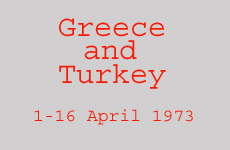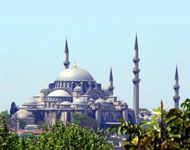|
Page 1 2 3 4 5 6 7 8 9 10 11 12
Wednesday, 5 April. We were taking another bus tour today, this one to the Argolis, the area around the city of Argos in the northeast Peloponnese. Our tour included Corinth, Mycenae, and Epidauros. The bus headed south from Athens and took us across the narrow isthmus at Corinth. The four mile long, steep-sided canal across the isthmus was amazing to see. It was not dug by the ancient Greeks as we first thought, however. It opened in 1893. Ancient Corinth was pretty much a field of rubble. The original Greek city was rebuilt by the Romans, so what structures can be made out date from Roman times. The Temple of Apollo (540 B.C.) is an exception, but even that was restored by the Romans.
From Corinth our bus continued on to Mycenae, situated on a small hilltop between the twin peaks of Mt. Euboea. We could see the ruins from a distance as we approached. I had studied ancient Greek and read the Iliad and the Odyssey in Greek. I was fascinated to see Mycenae, but surprised by its small size (about seven acres). Yet, the people from this little fortified hill town had dominated Greek civilization for five centuries (1600-1100 B.C.) and even conquered Crete and the some of the coast of Turkey (Troy).
We entered the town through the Lion Gate (about1250 B.C.) and climbed to the acropolis, passing the burial shafts and other grave sites that dominate the ruins. The burial shafts were first excavated by Heinrich Schliemann (who later excavated Troy). They contained richly dressed bodies adorned with gold, their faces covered by masks of gold. We had seen two of these masks in the Archeological Museum in Athens, including the one Schliemann called the Mask of Agamemnon. (It wasn't.)
Mycenae had been heavily fortified. Some of the roughly shaped stones that made up the walls were 18 feet thick and 37 feet tall, giving rise to the legend that they were carried here by the Cyclops, the mythical one-eyed giants. No one has figured out how these ancient Greeks moved such large stones.
It was difficult to identify any of the palaces or other buildings from their scant remains. Of course, what would one expect to find remaining after more than 3000 years? The only structures still intact were the beehive tombs (thalos) across the road from the rest of the ruins, and they were truly impressive. The Mycenaeans began to use such tombs, rather than the shaft graves, around 1500 B.C. From the outside, the tombs appeared to be natural hills, but with a stone entrance gate to the interior. Once inside, you could see that the “hill” was in fact a gigantic behive-shaped dome formed by concentric rings of huge stone blocks. The lintel at the entrance to one thalos, we were told, weighed more than 100 tons. We were puzzled that these elaborate tombs are so little known, compared to the pyramids, for example. I thought I knew a lot about the ancient Greeks, but I'd never heard of these tombs.
Leaving Mycenae, our tour had a lunch stop on the way to Epidaurus. Epidaurus was a renowned sanctuary of Asclepius, the god of health, but is best known now for its spectacular outdoor theater (4th century B.C.). With a second tier later added by the Romans, the theater seats 14,000 people. The acoustics are fantastic. Our guide had us all sit high in the upper rows; then he spoke softly and finally dropped a coin in the center of the stage. We could hear everything perfectly.
The drive back to Athens went quickly, and we were dropped off at our hotel before 16:00. On
our Monday morning walk, we had passed the Aliki Theater, featuring folk dancing performances.
We decided to see a performance tonight after dinner. It was only a short walk to the theater. The
show was very enjoyable. Afterwards we walked the short distance back to our hotel and retired
for the night.
Page 1 2 3 4 5 6 7 8 9 10 11 12
Copyright © 2000-2023 DarrellPeck.com All rights
reserved. | |





















